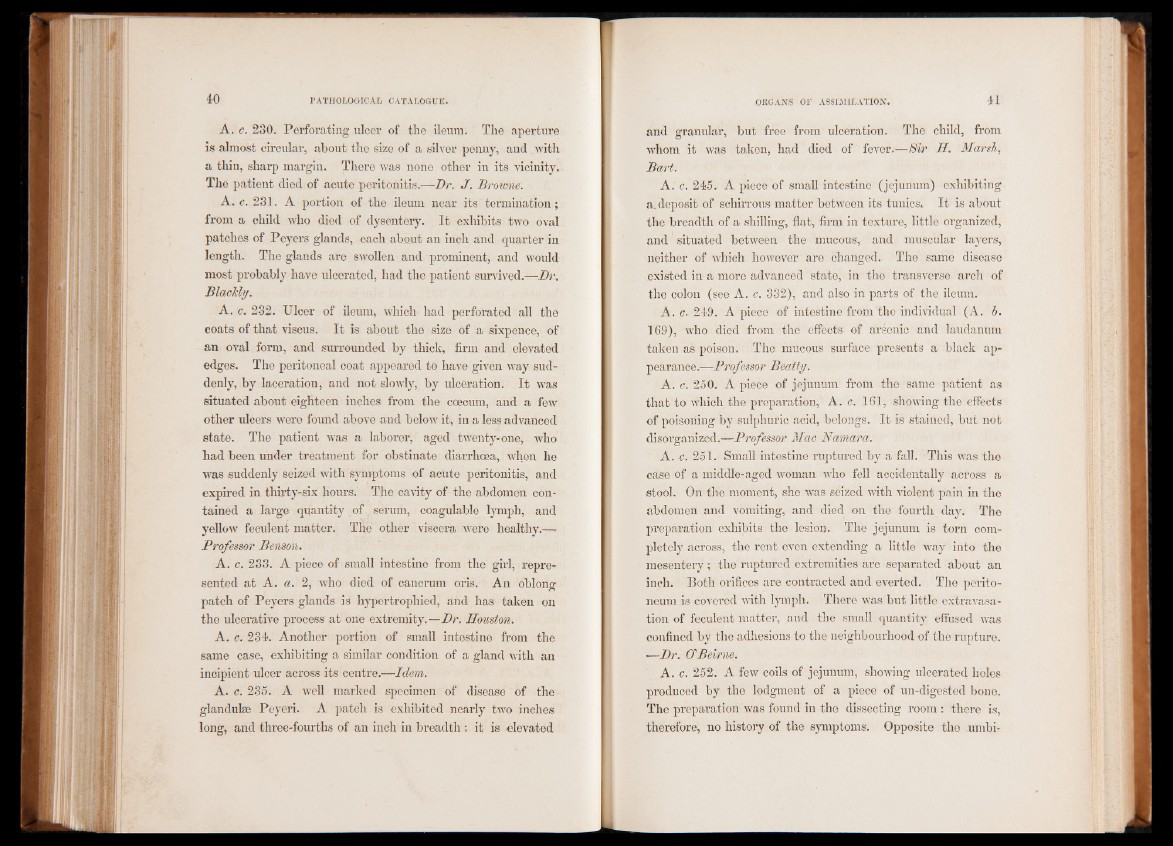
A. c. 230. Perforating ulcer of the ileum. The aperture
is almost circular, about the size of a silver penny, and . with
a thin, sharp margin. There was none other in its vicinity.
The patient died of acute peritonitis.—Dr. J. Browne.
A. c. 231. A portion of the ileum near its termination ;
from a child who died of dysentery. It exhibits two oval
patches of Peyers glands, each about an inch and quarter in
length. The glands are swollen and prominent, and would
most probably have ulcerated, had the patient survived.—Dr.
Blackly.
A. c. 232. Ulcer of ileum, which had perforated all the
coats of that viscus. It is about the size of a sixpence, of
an oval form, and surrounded by thick, firm and elevated
edges. The peritoneal coat appeared to have given way sud-
denly, by laceration, and not slowly, by ulceration. It was
situated about eighteen inches from the cæcum, and a few
other ulcers were found above and below it, in a less advanced
state. The patient was a laborer, aged twenty-one, who
had been under treatment for obstinate diarrhoea, when he
was suddenly seized with symptoms of acute peritonitis, and
expired in thirty-six hours. The cavity of the abdomen contained
a large quantity , of 3 serum, coagulable lymph, and
yellow feculent matter. The other viscera were healthy.—
Professor Benson.
A. c. 233. A piece of small intestine from the girl, represented
at A. a. 2, who died of cancrum oris. An oblong
patch of Peyers glands is hypertrophied, and has taken on
the ulcerative process at one extremity.—Dr. Houston.
A. c. 234. Another portion of small intestine from the
same case, exhibiting a similar condition of a gland with an
incipient ulcer across its centre.—Idem.
A. c. 235. A well marked specimen of disease of the
glandulæ Peyeri. A patch is exhibited nearly two inches
long, and three-fourths of an inch in breadth : it is -elevated
and granular, but free from ulceration. The child, from
whom it was taken, had died of fever.—Sir H. Marsh,
Bart.
A. c. 245. A piece of small intestine (jejunum) exhibiting
a. deposit of schirrous matter between its tunics* It is about
the breadth of a shilling, flat, firm in texture, little organized,
and situated between the mucous, and muscular layers,
neither of which however are changed. The same disease
existed in a more advanced state, in the transverse arch of
the colon (see A. c. 332), and also in parts of the ileum.
A. c. 249. A piece of intestine from the individual (A. h.
169), who died from the effects of arsenic and laudanum
taken as poison. The mucous surface presents a black appearance.—
Professor Beatty.
A. c. 250. A piece of jejunum froin the same patient as
that to which the preparation, A. c. 161, showing the effects
of poisoning by sulphuric acid, belongs. It is stained, but not
disorganized.—Professor Mac Namara.
A. c. 251. Small intestine ruptured by a fall. This was the
case of a middle-aged woman who fell accidentally across a
stool. On the moment, she was seized with violent pain in the
abdomen and vomiting, and died on the fourth day. The
preparation exhibits the lesion. The jejunum is torn completely
across, the rent even extending a little way into the
mesentery ; the ruptured extremities are separated about an
inch. Both orifices are contracted and everted. The peritoneum
is covered with lymph. There was but little extravasation
of feculent matter, and the small quantity effused was
confined by the adhesions to the neighbourhood of the rupture.
—Dr. (JBeirne.
A. c. 252. A few coils of jejunum, showing ulcerated holes
produced by the lodgment of a piece of un-digested bone.
The preparation was found in the dissecting room: there is,
therefore, no history of the symptoms. Opposite the umbi